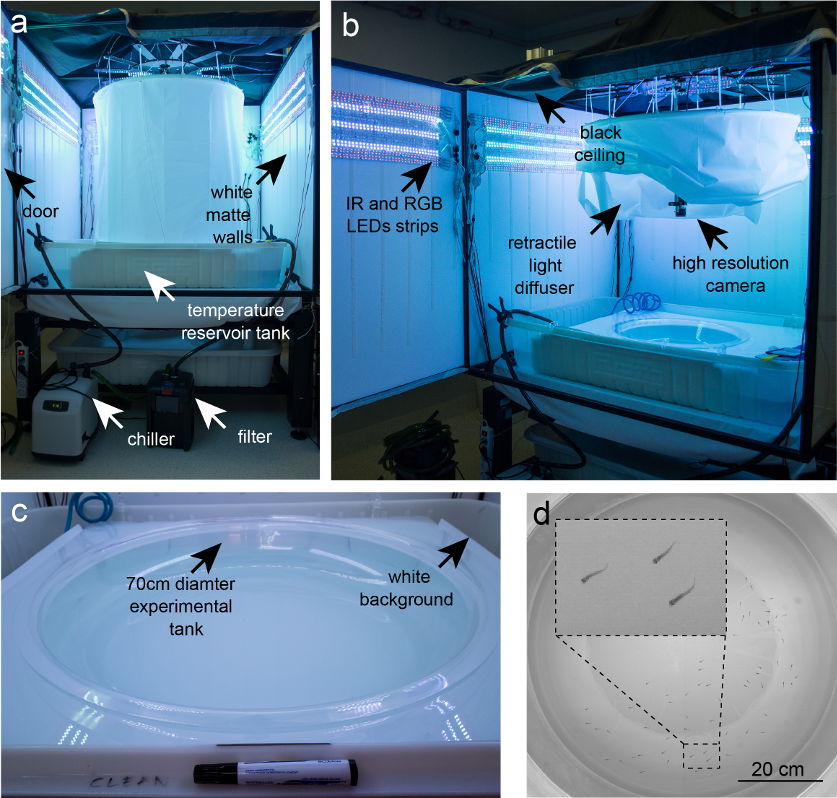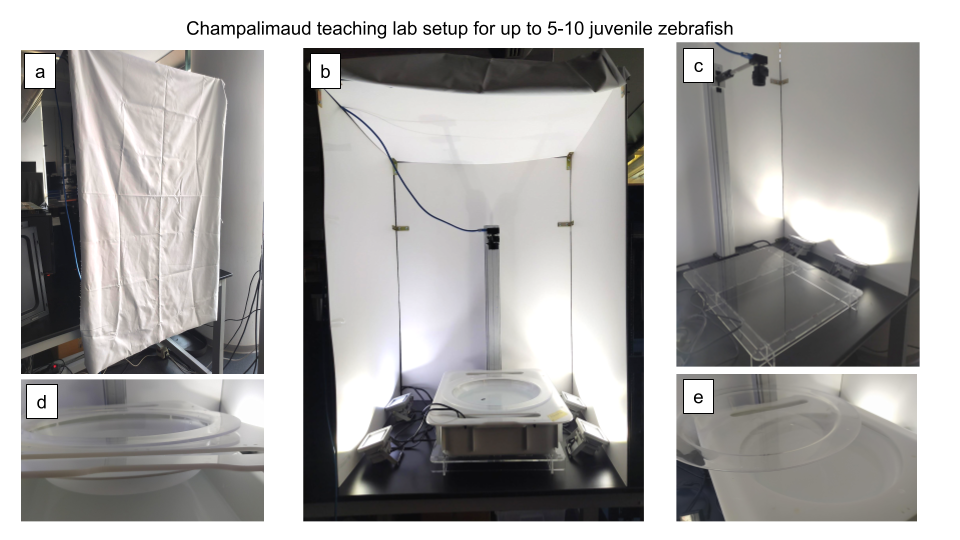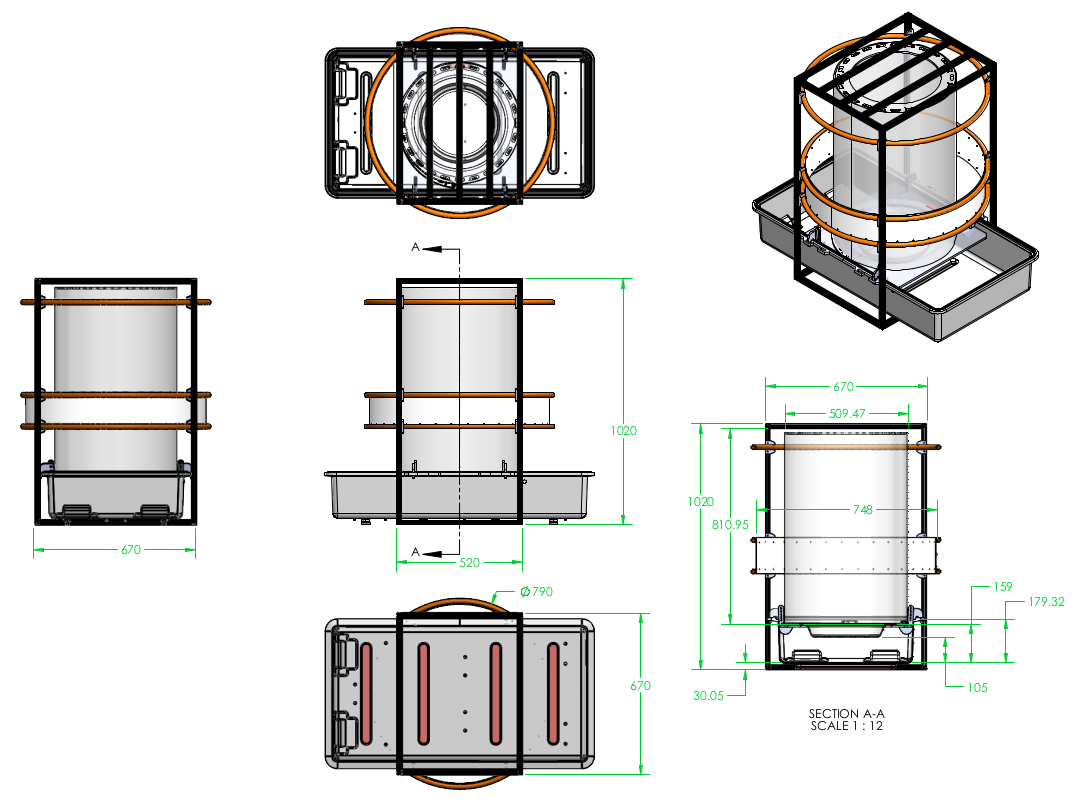Experimental setups#
Zebrafish (in the lab)#

Polavieja Lab setup for juvenile zebrafish (same as Supplementary Figure 3 of the paper)#
The main tank was placed inside a box built with matte white acrylic walls (a). The lighting was based on infrared and RGB LED strips. A cylindrical retractable light diffuser made of plastic ensured homogeneous illumination in the central part of the main tank. A 20 MP monochrome camera (Emergent Vision HT-20000M) with a 28 mm lens (ZEISS Distagon T* 28-mm f/2.0 Lens with ZF.2) was positioned approximately 70 cm from the surface of the arena. To prevent reflections of the room ceiling, we used black fabric to cover the top of the box (b). We used this setup to record zebrafish in groups and in isolation. Videos of groups of 10, 60 and 100 fish were recorded in a custom-made one-piece circular tank of 70-cm diameter, designed in-house. The tank was filled with fish system water to a depth of 2.5 cm. The circular tank was held in contact with the water of the main tank approximately 10 cm above a white background to improve the contrast between animals and background (c). A water-recirculating system equipped with a filter and a chiller ensured a constant water temperature of 28 °C.
In this link you can find the list of the different parts needed to build the experimental box, with its dimensions, and links to the Thorlabs webpage.
A simple and cheap way to build a cylindrical light diffuser is to use two plastic gymnastic hoop and a white translucent plastic shower curtain. You can use plastic zip ties to join the curtains to the hoop.
The Scientific Hardware Platform at the Champalimaud Foundation has helped us to design different parts of the setup. In particular, the acrylic circular tank is a key piece of the setup. As this tank is made of a single piece of acrylic it has not straight borders or corners. We find it to be very useful to avoid biasing the movement of the fish towards corners, which is common in rectangular tanks.
Here you have the different models of tanks that we have used in the lab:
We always use a transparent tank on top of a white matte acrylic version of the same tank that acts background and helps to increase the contrast between the animals and the background. We separate the tanks around 2-5 cm from each other (vertically), and fill also the white tank with water. This avoids reflections of the animals in the walls of the tank.
Zebrafish (in internal summer courses)#
For the course of the INPDP PhD programme in the Champalimaud and for the CAJAL behavior summer courses we designed a easy to replicate setup so that we could have 10 of them working in the Teaching lab in parallel.

INPDP and CAJAL sessions setup#
The setup consists of an experimental box of 80 x 110 x 70 cm with white matte walls and a white blackout curtain (see panel above). Different to the lab setup (above), which uses a diffuser, in this setup we use indirect light from 4 white LED spot light reflected on the white walls (see panel b above).
The experimental arena is a custom-made 30 cm transparent acrylic circular tank made of transparent acrylic (see panels b, d and e above). To improve the contrast between the animals and the background the setup has a custom-made white matte acrylic 30 cm circular bowl tank that is placed (see panels d and e above). Both the transparent arena and the white bowl are held an rectangular plastic tank with a custom-made white acrylic holder. For long recording, this rectangular tank can also contain water and a aquarium heater an pump to provide stable temperature conditions (after sufficient time, the water in all recipients will be at the same temperature by convection).
To provide a stable surface to hold the experimental tank, we build a custom-made acrylic platform that fits on top of the Thorlabs breadboard (see panel c above, see also the models here and here).
The arena is recorded from above with a PointGrey Chameleon 3 camera connected to a computer outside of the box (see panel a above) and a Fujinon lens 2.8-8mm f1.2. The camera is held to a Thorlabs pole, which at the same time is held into a 30x30cm Thorlabs breadboard (see panel c above).
Zebrafish (in external summer courses)#
For the 2018 QBIO Summer research course @KITP, UCSB we designed a portable setup that fitted protective flight case:

QBIO course setup#
Here you can find the model, the dimensions of the aluminum rails structure, the 300mm circular tank model, and the tank holder and light diffuser frame models.